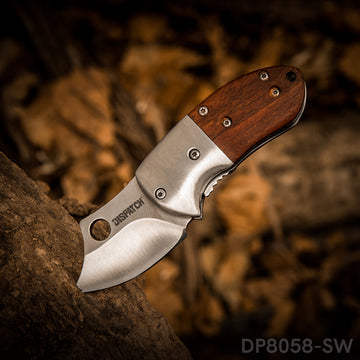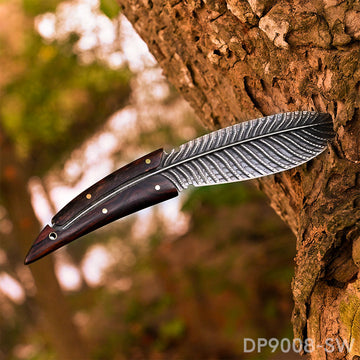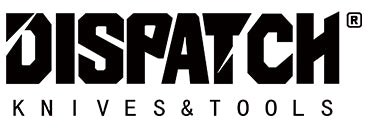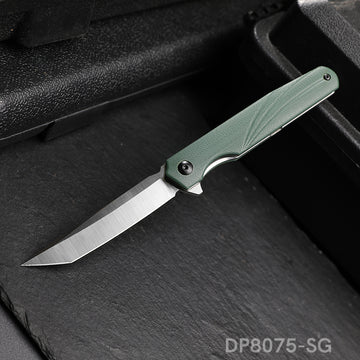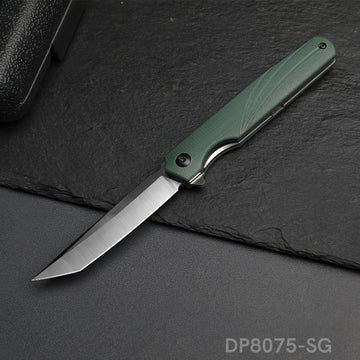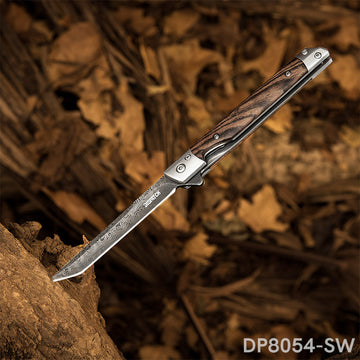Knife Handle Material Guides to Beginners
Many knife newbies may assume that the knife handle is just an aesthetic asset of a knife. In reality, the type of handle is extremely important to the overall performance of the knife. So what are the different handle materials, and what are their advantages and drawbacks? With that in mind, we’ve put together the following complete guide to knife handle materials for beginners. Let’s have a look…
There are tons and tons of different handle materials and we generally separate them into 3 types:
- Metals: Metal knife handles are widespread in the knife industry, which is strong, durable, and relatively cheap.
- Synthetics: These are the modern ones, and are now considered to be the most popular handle materials.
- Natural materials: The more traditional materials have a long history in knife making, and are still favored by knife collectors.
Let’s have a closer look at the materials in each types.
Metal
Metal is a great knife handle material due to its durability, strength, and easy maintenance. However, a metal handle is usually smooth, making it is difficult to grip, especially with a wet hand. Therefore, many knives with metal handles feature textured designs or a brushed satin finish for a better grasp. The three most common metals in knife handles are aluminum, stainless steel, and titanium.
Stainless Steel
Stainless steel provides excellent durability and resistance to corrosion but is heavier than any other metal. Besides, stainless steel handles can be rather slippery. For a better grip, knife makers often combine it with other materials like plastic or rubber. A knife with stainless steel handle is not quite recommended for EDC or survival due to its heavyweight,.
Pros: strong, durable, corrosion-resistant, cheap, no scratches, no dents.
Cons: heavy, can be slippery
Stainless Folding Knife from DISPATCH KNIVES >>

Aluminium
Aluminum is a very popular metal that is strong, corrosion-resistant, lightweight, and cheap. It can be anodized into just about any color, which makes for a great style addition to any knife, and also adds some extra hardness. However, being so lightweight, aluminum handles can be prone to scratches and dents.
Pros: Tough, lightweight, corrosion-resistant,coloring options
Cons: Feels cold, slippery,prone to scratching
Aluminum Rescue Knife from DISPATCH KNIVES >>

Titanium
Titanium is a very lightweight metal with low-density, high-strength, and similar corrosion-resistant properties to stainless steel. It doesn’t feel as cold as other metals and can be anodized just the same as aluminum. However, it is also the most expensive common metal used in knife handles. Besides, titanium is not indestructible and can suffer from scratching much more than stainless steel.
Pros: very lightweight, durable, corrosion resistant
Cons: more expensive than other metals, can be prone to scratching
Synthetics
Synthetic handles usually come in the form of acrylic, plastic, resin, and other composites. They are now the most popular handle types due to their unique looks, better grip, a complete rust defense, and a wide array of shapes and colors. The main ones used in synthetic handles are carbon fiber, G10, and Micarta.
Carbon Fiber
Carbon fiber is a very high-tech material, because of its incredible strength, lightweight properties, and futuristic looks! Just like a lot of synthetic materials, it is brittle and can crack due to heavy impact. Because Carbon fiber requires a long, laborious production process, it is a very expensive material to incorporate into a knife.
Pros: the strongest, durable and water-resistant,cool futurist
Cons: Brittle

G10
G10 is a popular handle material, known to be a ‘fiberglass composite laminate’. It is extremely durable, water-resistant, and lightweight. G10 handles are usually textured for a good hand grip and can be customized in various colors and textures. The material is in many ways similar to carbon fiber, but it is much cheaper!
Pros: sturdy grip, durable and water-resistant
Cons: Brittle
G10 Handle and D2 Blade Pocket Knife from DISPATCH KNIVES >>

Micarta
Micarta is very lightweight, extremely tough, and superbly durable. Micarta is naturally smooth but is easily textured to improve the grip. The production process gives the Micarta handle a very unique look in a wide variety of colors.
Pros: tough, lightweight, durable, water-resistant. customizing options
Cons: Expensive, brittle
Micarta Handle Pocket Knife from DISPATCH KNIVES >>

Natural & Organic
Natural materials have been used for thousands of years in knife making. Natural materials may include bone, leather, mother of pearl, and wood.
Wood
Wood is by far the most popular natural handle material for knives. It offers lots of variety in different woods and is easy to hold. A good-quality wooden handle will be strong, durable, and aesthetically appealing. It adds a lot of beauty to a knife, which is why it is very popular among collectors.
Pros: traditional, comfortable, attractive, lots of options
Cons: Requires maintenance, unstable
Wood Handle Fixed Blade Knife from DISPATCH KNIVES >>

Bone
Bone handles can be textured and colored, but are often slippery and suffer from damage when repeatedly exposed to the elements.
Pros: traditional, inexpensive
Cons: susceptible to cracking, slippery
Mother of Pearl
The Mother of Pearl material is of course an expensive material but extremely stylish.
Pros: Natural beauty
Cons: Expensive, slippy
